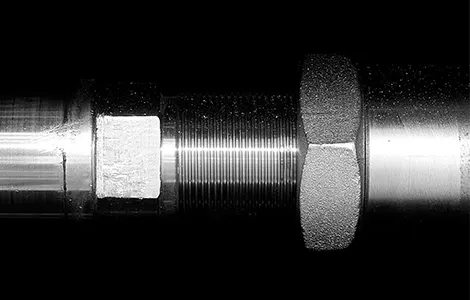Preventing Steel Belt Drift: The Role of Belt Tracking Rollers in Industrial Operations
May 30, 2025
In industrial environments where conveyor systems are central to production efficiency, maintaining precise belt alignment is crucial. Belt drift or misalignment not only compromises operational efficiency but also accelerates wear, leading to costly downtime and maintenance. A key solution lies in the strategic use of tracking rollers and sophisticated belt tracking systems — core technologies offered by PACE. But how exactly do these components prevent belt drift, and what makes them indispensable in high-demand industrial settings?
Understanding Belt Drift and Its Causes
Belt drift occurs when a conveyor belt moves off its intended track during operation. This deviation can result from several factors, including:
- Uneven Tension: Differences in belt tension across the width of the conveyor can cause one side to pull harder than the other.
- Poor Installation: Misalignment during installation sets a conveyor belt up for ongoing tracking issues.
- Material Build-up: Accumulated material on rollers or pulleys creates surface irregularities that impact tracking.
- Wear and Tear: Over time, components such as rollers and pulleys degrade, affecting the belt’s stability.
- Environmental Factors: Temperature changes, moisture, and particulate contamination can all influence belt behaviour.
Unchecked belt drift can lead to belt edge damage, excessive wear on conveyor components, increased energy consumption, and unplanned production stoppages.
The Impact of Operating Without Belt Tracking Rollers
Without effective belt tracking rollers or tracking systems in place, industrial operations can face significant challenges. Belt misalignment can quickly escalate into serious production issues, including frequent stoppages for manual realignment, increased belt edge wear, and accelerated damage to critical conveyor components. Misaligned belts may also result in inconsistent product handling, material spillage, and higher energy consumption due to increased friction.
Over time, this not only impacts output quality but also leads to higher maintenance costs and reduced system lifespan. In sectors where uptime and product consistency are essential, the absence of proper belt tracking measures can severely undermine operational efficiency and profitability.
The Engineering Behind Belt Tracking Rollers and Systems
Tracking rollers, also known as belt tracking rollers or belt conveyor rollers, are critical to maintaining alignment. At PACE, our belt tracking systems are expertly engineered to detect and correct belt drift through precise mechanical responses.
Key engineering features of PACE's tracking solutions include:
- Pivoting Rollers: Automatically react to misalignment by subtly adjusting the belt's direction.
- High-Sensitivity Designs: Allow for quick correction of minor deviations before they develop into major issues.
- Durable Construction: Manufactured from robust materials capable of withstanding high operating temperatures, heavy loads, and abrasive conditions typical in steel belt applications.
- Minimal Maintenance Needs: Built for longevity and continuous use, our systems reduce the maintenance burden on operators.
PACE's custom-designed tracking roller technology not only applies corrective pressure on the wandering side of the belt but also steers the belt gently, minimising edge stresses and enhancing overall belt performance.
PACEMatic: Automated Precision for Belt Tracking
In addition to traditional tracking rollers, we offer the PACEMatic automatic belt tracking system — a significant innovation in conveyor belt management. PACEMatic is engineered to tackle both belt positioning and tensioning challenges. This system not only maintains constant pressure through thermal expansion but also ensures central belt running, maximising belt utilisation and significantly extending belt life.
How Tracking Systems Enhance Industrial Operations
The benefits of integrating belt tracking rollers and systems into a steel belt conveyor are substantial:
- Reduced Downtime: By correcting belt misalignment early, tracking systems prevent the need for unplanned maintenance stops.
- Extended Belt and System Lifespan: Proper alignment reduces wear on both the belt edges and the entire conveyor structure.
- Enhanced Safety: Eliminating belt drift minimises the risk of material spills and mechanical failures, ensuring safer working environments.
- Improved Product Consistency: Consistent belt alignment ensures products are conveyed without interruption, vital for industries such as food processing and chemical production.
PACE's expertise ensures that each belt tracking solution, whether manual or automatic, is tailored to the application, considering belt width, operating speed, environmental conditions, and load characteristics.
Conclusion
Preventing steel belt drift is essential for maintaining the efficiency, safety, and longevity of industrial conveyor systems. Through precision-engineered belt tracking rollers and our innovative PACEMatic automatic tracking systems, PACE delivers dependable solutions that correct misalignment before it impacts operations. Our tracking technology not only supports smoother production but also protects your investment in conveyor equipment.
To discover more about our advanced belt tracking solutions and how they can enhance your operations, contact the PACE team today.
Belt Drift FAQs:
What are the early warning signs of belt drift in steel belt systems?
Early signs include uneven wear on belt edges, abnormal tracking marks, material spillage, and frequent manual adjustments during operation. Regular monitoring can prevent major issues.
How does belt drift impact overall steel conveyor belt system efficiency?
Belt drift leads to increased friction, higher energy consumption, reduced material handling precision, and accelerated wear on belts and conveyor components, ultimately lowering operational efficiency.
Are tracking rollers suitable for all types of steel belts?
Yes, PACE’s tracking rollers are designed to be compatible with a wide range of steel belts used across food processing, chemical production, and industrial manufacturing applications.
What factors should be considered when choosing a belt tracking system for steel belt conveyors?
Key considerations include belt width, operational speed, load characteristics, environmental conditions, and whether the system requires manual or automatic adjustment capabilities.
How does PACEMatic differ from traditional belt tracking rollers?
PACEMatic is an automated system that continuously adjusts belt tension and alignment, maintaining optimal belt positioning through thermal expansion and operational changes without manual intervention.
Is it possible to retrofit an existing steel conveyor belt system with PACEMatic?
Yes, PACE engineers can assess existing conveyor setups and retrofit PACEMatic systems where feasible, improving belt tracking precision and extending belt longevity without major structural changes.

